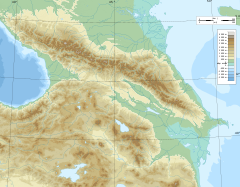Mezmaiskaya cave
| Мезмайская пещера | |

area around Mezmaiskaya Cave
|
|
| Location | Sukhoi Kurdzhips |
|---|---|
| Region | Republic of Adygea, North Caucasus, Russia |
| Type | limestone karst |
| History | |
| Periods | Paleolithic |
| Associated with | Homo neanderthalensis |
Mezmaiskaya Cave (Russian: Мезмайская пещера is a prehistoric cave site overlooking the right bank of the Sukhoi Kurdzhips (a tributary of the Kurdzhips River) in the southern Russian Republic of Adygea, located in the northwestern foothills of the North Caucasus in the Caucasus Mountains system.
Initial excavations in the Mezmaiskaya cave recovered Mousterian artifacts of the Last glacial period, dated to about 35,000 B.P. and older.
However, a rib fragment from the partial skeleton of a Neanderthal infant found in the cave was radiocarbon-dated to 29,195 ± 965 years B.P. and therefore belonging to one of the most recent individual Neanderthal specimens. The date accuracy obtained from the bone rather than from associated assemblages accounts for the most reliable date available.
Ancient DNA was recovered for a mtDNA sequence showing 3.48% divergence from that of the Neanderthal 1, found some 2,500 km (1,600 mi) to the west in Germany. Phylogenetic analysis places these two specimen in a clade distinct from modern humans, suggesting that their mtDNA types have not contributed to the modern human mtDNA pool.
Three Neanderthal individuals were recovered from the cave. The first, Mezmaiskaya 1 is the almost complete skeleton in a well preserved state due to calcite cementation that covers and holds the arrangement in place. It was assessed to be an infant about two weeks old, making it the youngest Neanderthal ever recovered. Although no burial pit was found, circumstances suggest that the body was buried intentionally, explaining the good state of preservation and the lack of scavenger marks. Only the skull fragments of a Neanderthal child - Mezmaiskaya 2 - were found and a recovered tooth was assigned to Mezmaiskaya 3.
...
Wikipedia


